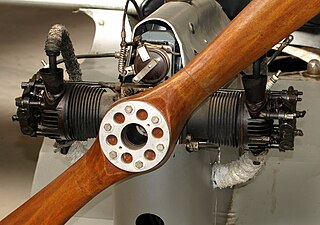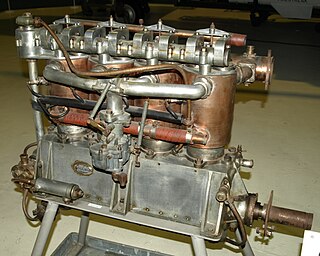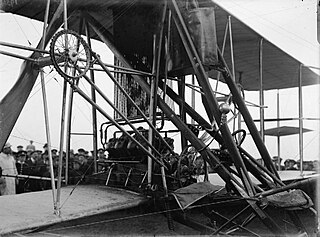Related Research Articles

The Monosoupape, was a rotary engine design first introduced in 1913 by Gnome Engine Company. It used a clever arrangement of internal transfer ports and a single pushrod-operated exhaust valve to replace the many moving parts found on more conventional rotary engines, and made the Monosoupape engines some of the most reliable of the era. British aircraft designer Thomas Sopwith described the Monosoupape as "one of the greatest single advances in aviation".

The Rolls-Royce Eagle was the first aircraft engine to be developed by Rolls-Royce Limited. Introduced in 1915 to meet British military requirements during World War I, it was used to power the Handley Page Type O bombers and a number of other military aircraft.

Blériot Aéronautique was a French aircraft manufacturer founded by Louis Blériot. It also made a few motorcycles between 1921 and 1922 and cyclecars during the 1920s.

The Clerget 9B was a nine-cylinder rotary aircraft engine of the World War I era designed by Pierre Clerget. Manufactured in both France and Great Britain, it was used on such aircraft as the Sopwith Camel. The Clerget 9Bf was an increased stroke version.

The Siddeley Tiger was an unsuccessful British aero engine developed shortly after the end of World War I by Siddeley-Deasy. Problems encountered during flight testing caused the project to be cancelled.
The Advance Motor Manufacturing Company was a British motorcycle and engine manufacturer established in 1905. As well as supplying aircraft engines to the pioneering monoplane developers, Advance engines were also used by Captain Robert Scott to power Antarctic snow sleds. After the end of the Second World War the company was sold to Sheepbridge Engineering and became a motor supplies organisation.

The ABC 8 hp is an 8 hp (6 kW) two-cylinder aero engine designed by the noted British engineer Granville Bradshaw for use in ultralight aircraft. The engine was derived from a specially tuned motorcycle unit and was built by ABC Motors, first running in 1923.
The de Havilland Ghost was a British V-8 aero engine that first ran in 1928.

The Beardmore 120 hp was a British six-cylinder, water-cooled aero engine that first ran in 1914, it was built by William Beardmore and Company as a licensed-built version of the Austro-Daimler 6. The engine featured cast iron cylinders and mild steel concave pistons. Produced between August 1914 and December 1918, the design powered many World War I aircraft types.

The Green C.4 was a British four-cylinder, water-cooled aero engine that first ran in 1908, it was designed by Gustavus Green and built by the Green Engine Co and Aster Engineering. The engine was one of two Green designs to win a government prize.

The Green E.6 was a British six-cylinder, water-cooled aero engine that first ran in 1911, it was designed by Gustavus Green and built by the Green Engine Co and Mirlees, Bickerton & Day of Stockport between August 1914 and December 1918.

Cecil Howard Pixton was a British aeronautical engineer, test pilot and air racing pilot who was most famous for winning the 1914 Schneider Trophy seaplane race.

The Green D.4 was a four-cylinder watercooled inline piston engine produced by the Green Engine Co in the UK in 1909. It produced about 60 hp (45 kW) and played an important role in the development of British aviation before World War I.

The de Havilland Iris was a British four-cylinder, liquid-cooled, horizontally opposed aero engine. Notable as the first aero engine to be designed by Geoffrey de Havilland it was produced in small numbers between 1909 and 1910 by Iris Cars Ltd of Willesden from which it took its name.

E.N.V. was an early manufacturer of aircraft engines, originally called the London and Parisian Motor Company their first model appearing in 1908. E.N.V. engines were used by several pioneer aircraft builders and were produced in both France and the UK until about 1914. They subsequently specialised in camshafts and bevel gear manufacture until 1968 when the name was lost.

The Salmson water-cooled aero-engines, produced in France by Société des Moteurs Salmson from 1908 until 1920, were a series of pioneering aero-engines: unusually combining water-cooling with the radial arrangement of their cylinders.

The Gnome 7 Omega is a French seven-cylinder, air-cooled aero engine produced by Gnome et Rhône. It was shown at the Paris Aero Salon held in December 1908 and was first flown in 1909. It was the world's first aviation rotary engine produced in quantity. Its introduction revolutionized the aviation industry and it was used by many early aircraft. It produced 37 kW (50 hp) from its 8 L (490 cu in) engine capacity. A Gnome Omega engine powers the 1912 Blackburn Monoplane, owned and operated by the Shuttleworth Collection, the oldest known airworthy British-designed aeroplane worldwide. A two-row version of the same engine was also produced, known as the Gnome 14 Omega-Omega or Gnome 100 hp. The prototype Omega engine still exists, and is on display at the United States' National Air and Space Museum.
The Gnome 7 Gamma was a French designed, seven-cylinder, air-cooled rotary aero engine. Powering several pre-World War I era aircraft types it produced 70 horsepower (52 kW) from its capacity of 12 litres.

The Cody Michelin Cup Biplane was an experimental aircraft designed and built in Britain during 1910 by Samuel Franklin Cody, a prominent showman and aviation pioneer. Cody had worked with the British Army on experiments with man-lifting kites and in October 1908 had successfully built and flown the British Army Aeroplane No 1, making the first officially verified powered flight in the United Kingdom. Cody broke the existing endurance record twice in the aircraft, the second flight, made on 31 December 1910, winning him the Michelin Cup for the longest-lasting flight made over a closed circuit in the United Kingdom before the end of the year.

The Boland V-8 was an aircraft engine that was developed by the Boland Brothers for use in their tailless aircraft. Between 1908 and 1914, four versions of this motor were produced ranging in power from 60 hp (45 kW) to 125 hp (93 kW). The Boland motors all used an unusual concentric overhead valve. This arrangement positioned the intake valve in the middle of the exhaust valve. These were actuated by a single push rod and rocker arm.
References
Notes
- 1 2 3 Gunston 1986 , p. 72
- ↑ Lumsden 1994 , pp. 154–6
- 1 2 Anon, The Motorcycle, no. 695, Volume 13, 29 October 1914, p.482
- ↑ Flight 1911
- ↑ Flight 1913
- 1 2 "Aeroplane Engine Tests. Army Council Awards". News. The Times. No. 40667. London. 16 October 1914. col G, p. 10.
- ↑ Flight (23 October 1914, p.1062) states the prize was awarded to the 120 hp (89 kW) engine, a refinement of the 100 hp (75 kW) model, unlike "The Motorcyclist"[ citation needed ]
- ↑ "An 8 h.p. Twin-cylinder Zenith-Green", Motor Cycle, 20 August 1914, p.248.
- ↑ Jane 1969 , p. 3c
- ↑ Flight 23 October 1914 p.1062
- ↑ Barnes 1967, p.52
- 1 2 Bruce 1992, p. 260
- ↑ Barnes & James 1987, p. 64
- ↑ Lewis 1962, p. 476
- ↑ "The Motor-Boats at Monaco". Sport. The Times. No. 39242. London. 9 April 1910. col C, p. 18.
Bibliography
- Bartley, L.J. (1971). The History of Bexhill. p. 94 – first successful British aero engine.
- Bruce, J.M. (1992). The Aeroplanes of the Royal Flying Corps (2nd ed.). London: Putnam Publishing. ISBN 0-85177-854-2.
- Barnes, C.H.; James, D. N. (1987). Handley Page Aircraft since 1907. London: Putnam Publishing. ISBN 0-85177-803-8.
- Barnes, C.H. (1967). Shorts Aircraft Since 1900. London: Putnam P.
- Goodall, Michael H.; Tagg, Albert E. (2001). British Aircraft before the Great War. Atglen, PA, USA: Schiffer Publishing Ltd. ISBN 0-7643-1207-3.
- Gunston, Bill (1986). World Encyclopedia of Aero Engines. Wellingborough: Patrick Stephens. p. 72.
- Jane, Fred T. (1969). Jane's All the World's Aircraft 1913. London: David & Charles. ISBN 07153-4388-2.
- Lewis, Peter (1962). British Aircraft 1809–1914. London: Putnam Publishing.
- Lumsden, Alec (1994). British Piston Aero-engines and their Aircraft. Shrewsbury: Airlife. ISBN 1-85310-294-6.
- "Interim Report of the Government Flight Office and Official Results of the Alexander Competition". Flight . Vol. III, no. 2. 14 January 1911. p. 23. Retrieved 21 June 2018.
- "Flight Engines at Olympia". Flight . Vol. V, no. 6. 8 February 1913. p. 151. Retrieved 21 June 2018.